Agile & Lean at Tekes
4 likes2,383 views
10 min intro for TEKES regarding lean, agile and lean startup.
1 of 18
Downloaded 14 times
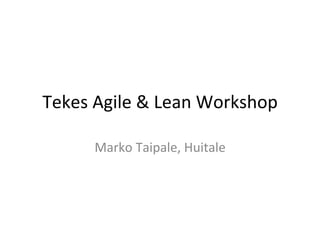

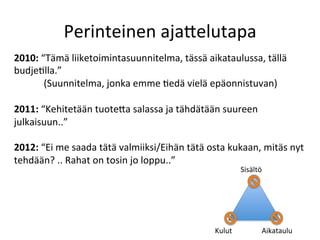

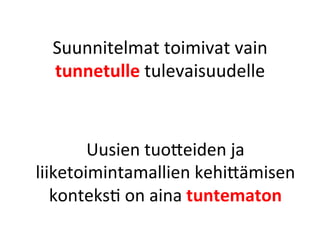

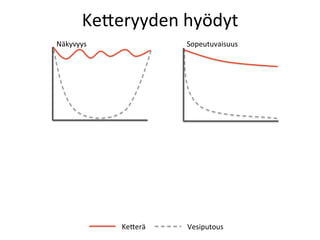
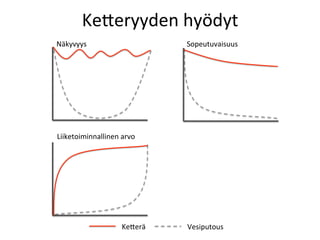
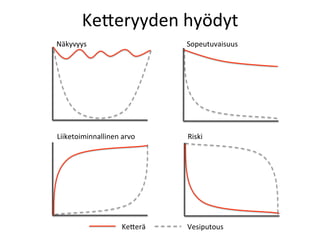

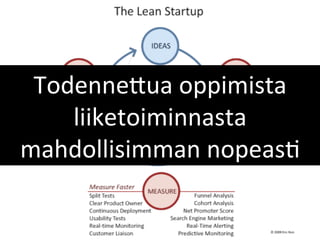
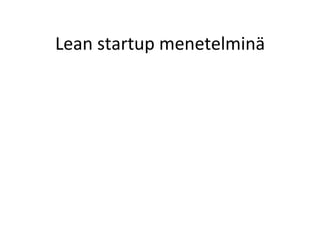


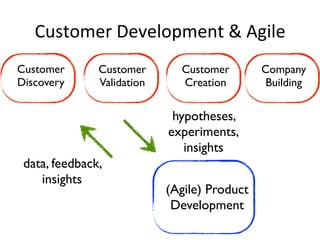
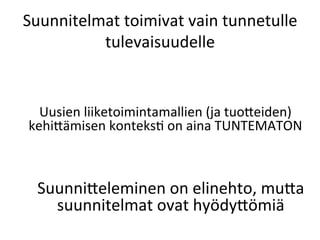
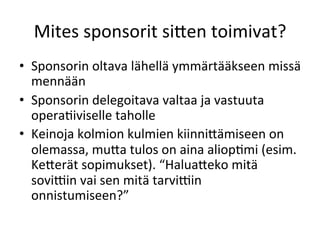

Ad
Recommended
Julkishallinnon IT-hankinnat @Mearra
Julkishallinnon IT-hankinnat @MearraMarko Taipale
╠²
Julkishallinnon tilaisuudessa pidetty esitys ketter├żst├ż kehityksest├ż.Teknisen taitamisen merkitys ketteryydess├ż - n├żpertely├ż vai elinehto?
Teknisen taitamisen merkitys ketteryydess├ż - n├żpertely├ż vai elinehto?Marko Taipale
╠²
My presentation slides from Tieturi-event 24.4.2012PELOTON: Tuotev├żyl├ż ja peloton
PELOTON: Tuotev├żyl├ż ja pelotonDemos Helsinki
╠²
Keksint├Čs├ż├żti├Čn Tuotev├żyl├ż-ohjelma voi tarjota monenlaista tukea, kun Peloton-konsepteja halutaan vied├ż kohti toteutusta. Tuotev├żyl├ż├ż esitteli Mia Fohlin Keksint├Čs├ż├żti├Čst├ż. Lean kehitt├żmisen v├żlineen├ż / MS SOSTE 2016
Lean kehitt├żmisen v├żlineen├ż / MS SOSTE 2016Markus Meurman
╠²
LEAN on ennen kaikkea tapa ajatella toiminnan kehitt├żmist├ż. Toyotan toimintatavoista johdettu ajatusmalli keskittyy erityisesti k├żyt├żnn├Čnl├żheiseen jatkuvaan parantamiseen sek├ż ihmisten kunnioittamiseen. N├żen molemmat periaatteet erityisen t├żrkein├ż SOTE-sektorilla, jossa ihminen ja ihmisyys on kaiken keski├Čss├ż. LEAN-ty├Čkaluja on valtavat m├ż├żr├żt, mutta niiden kaikkien k├żytt├żminen ei ole itsetarkoitus. Ajattelumallin k├żytt├Č├Čnotto parin hyvin valitun ty├Čkalun avulla on erinomainen tapa aloittaa LEAN-kulttuurin rakentaminen.Kettera╠ł hankinta - Miten onnistut kehitysresurssien ostamisessa?
Kettera╠ł hankinta - Miten onnistut kehitysresurssien ostamisessa?Karoliina Luoto
╠²
Suomessa t├żll├ż hetkell├ż suosituin ketter├żn hankinnan muoto on resurssien ostaminen. Siin├ż onnistumisen ytimess├ż ovat l├żpin├żkyvyys, vastuu visiosta - my├Čs teknologian suhteen, budjetin strateginen k├żytt├żminen ja kyky yhteisty├Čn johtamiseen. Esitys Projektip├żivill├ż 31.10.2017.Tuotev├żyl├ż ja peloton 031211
Tuotev├żyl├ż ja peloton 031211Miia Fohlin
╠²
Tuotev├żyl├ż presentation to Peloton Innovation Camp participants in December 2011Lean ohjelmistokehityksess├ż
Lean ohjelmistokehityksess├żKaroliina Luoto
╠²
Mit├ż lean ohjelmistokehitys on k├żyt├żnn├Čss├ż vuonna 2019? Mit├ż muut voisivat oppia siit├ż, miten leani├ż ohjelmistokehitysalalla sovelletaan? Mist├ż pit├żisis aloittaa kun haluaa leaniytt├ż├ż softakehityksen? Karoliina Luoto vastasi n├żihin kysymyksiin Lean 2019 -seminaarissa Scandic Parkissa 26.3.2019.Agile ClearCase Rwsug.fi 2009
Agile ClearCase Rwsug.fi 2009mteinonen
╠²
Presentation in Finnish about agile development and some thoughts how to use IBM Rational ClearCase.
This was held in RWSUG.fi miniseminar 2009-03-19SAP-ohjelmistojen laadun kehitt├żminen monitoimittajaymp├żrist├Čss├ż - case Elisa
SAP-ohjelmistojen laadun kehitt├żminen monitoimittajaymp├żrist├Čss├ż - case Elisamikkomr
╠²
Presentation from the SAP Finug technology seminar (Sep 23-24 2010) highlighting the QM challenges and solutions in a multi vendor environment, Finnish only.Johdanto leaniin ja ketter├ż├żn tietoty├Čh├Čn
Johdanto leaniin ja ketter├ż├żn tietoty├Čh├ČnHouston Inc. Consulting Oy
╠²
Johdanto leaniin ja ketter├ż├żn tietoty├Čh├Čn - Houston Inc.Scrum-menetelm├żn k├żytt├Č Pirkanmaalaisissa ohjelmistoyrityksiss├ż
Scrum-menetelm├żn k├żytt├Č Pirkanmaalaisissa ohjelmistoyrityksiss├żJyri Vuorinen
╠²
Yhteenveto diplomity├Čst├żni "Scrum-menetelm├żn k├żytt├Č Pirkanmaalaisissa ohjelmistoyrityksiss├ż"
In english:
http://www.slideshare.net/jvuorinen/the-use-of-the-scrum-method-in-it-companies-in-pirkanmaa-areaLean it aamiaisseminaari2016_06
Lean it aamiaisseminaari2016_06Pentti Virtanen
╠²
Lean IT katsaus. Lean teollisuustuotannossa, palveluisssa, IT palveluissa, tuotekehityksess├ż ja ohjelmistotuotannossa. Lean IT k├żyt├żnn├Čss├ż, Kanban, Scrum, Scrumban. Talent Base ja Nitor Creations: Pragmatic Agile
Talent Base ja Nitor Creations: Pragmatic AgileLoihde Advisory
╠²
Pragmatic Agile:
Mik├ż se on?
Miten se toimii k├żyt├żnn├Čss├ż?
Mit├ż asiakas siit├ż hy├Čtyy?Lean start up Kuopio 24.9.2014
Lean start up Kuopio 24.9.2014Suomen Ekonomit
╠²
Materiaali Lean Start Up -koulutuksesta, Kuopio 24.9.2014Innovation Bootcamp 2014
Innovation Bootcamp 2014Business Arena Oy
╠²
Business Arenan oppimisleirin tuloksia ja oppeja. www.businessarena.fiHow to be a Lean Product Developer? @Agile Riga Day 2012
How to be a Lean Product Developer? @Agile Riga Day 2012Marko Taipale
╠²
The document provides guidance for lean product development. It recommends:
1. Validating business ideas through customer development and getting feedback to turn ideas into a series of testable hypotheses rather than guesses.
2. Building software faster using techniques like acceptance test-driven development (ATDD) and just-in-time architecture to minimize waste and inventory in the development process.
3. Measuring key metrics to understand customer needs and prioritize features, determine when requirements are met, and track progress over time.Showing the unseen @Scan-Agile 2012
Showing the unseen @Scan-Agile 2012Marko Taipale
╠²
This document describes several case studies involving companies transitioning to more agile ways of working.
The first case study involves an international gaming company that was trying to speed up product development. Mapping their entire value stream and showing areas of waste and delay helped them transition to Scrum and reduce their time-to-market from 24 months to 3 months.
The second case study involves a software product company that was just starting to adopt Scrum. Mapping out their current roles and processes revealed a lack of clear responsibilities that was causing confusion and delays. Introducing a Chief Product Owner role helped clarify responsibilities and align the various teams.
The third case study involves a company that was developing a new way of working toLet it grow empowering nature in our future cities, Mette Skjold
Let it grow empowering nature in our future cities, Mette SkjoldYIT Corporation
╠²
Let it grow - Empowering nature in our future cities
Mette Skjold, Managing Director & Partner, Architect, SLA
Urban development puts a massive pressure on the blue and green structures of our natural environment. But why spend resources on suppressing nature in our cities when we can create values for everyday life ŌĆō and prosperity - by setting it free?
Kest├żv├żt kaupunkiymp├żrist├Čt seminaari 25.11.2014, Helsinki, Finlandia-taloARA Otodom_Pozna┼ä_14 maja
ARA Otodom_Poznań_14 majaOtodom
╠²
Akademia Rozwoju Agenta Otodom: Jak skutecznie promowa─ć nieruchomo┼øci w internecie. Spotkanie w Poznaniu.Kokemukset nopeista kokeiluista Kalasatamassa -esitys 16.11.2016
Kokemukset nopeista kokeiluista Kalasatamassa -esitys 16.11.2016DigitalHelsinki
╠²
Fiksussa Kalasatamassa on nopeiden kokeilujen kautta kiihdytetty kaupunkikehityst├ż, avattu mahdollisuus kurkistaa tulevaisuuteen ja osallistettu asukkaita sen luomiseen.
Kokemusten esittelij├żn├ż on Forum Virium Helsingin kehitysp├ż├żllikk├Č Katja Spilling. Esitys on pidetty Helsingin kaupungin Digiryhm├żn tapaamisessa 16.11.2016. Katso esityksest├ż videotallenne Helsinki-kanavalta: http://www.helsinkikanava.fi/www/kanava/fi/videot/video?id=3234 .
Kanban, devops, lean startup
Kanban, devops, lean startup Juhana Huotarinen
╠²
Esityksess├ż kuvataan, miten Kanban, DevOps ja Lean Startup muuttavat perinteist├ż ketter├ż├ż ohjelmistoprosessiaLiiketoimintamalli ja Lean Startup
Liiketoimintamalli ja Lean StartupLauri Kutinlahti
╠²
Luennoin Tampereen teknillisen yliopiston Liiketoimintasuunnitelma kurssilla erilaisista liiketoimintamalleista ja Lean Startup-meneltem├żst├ż. T├żss├ż luentorunkoni tutustuttavaksi.More Related Content
What's hot (11)
SAP-ohjelmistojen laadun kehitt├żminen monitoimittajaymp├żrist├Čss├ż - case Elisa
SAP-ohjelmistojen laadun kehitt├żminen monitoimittajaymp├żrist├Čss├ż - case Elisamikkomr
╠²
Presentation from the SAP Finug technology seminar (Sep 23-24 2010) highlighting the QM challenges and solutions in a multi vendor environment, Finnish only.Johdanto leaniin ja ketter├ż├żn tietoty├Čh├Čn
Johdanto leaniin ja ketter├ż├żn tietoty├Čh├ČnHouston Inc. Consulting Oy
╠²
Johdanto leaniin ja ketter├ż├żn tietoty├Čh├Čn - Houston Inc.Scrum-menetelm├żn k├żytt├Č Pirkanmaalaisissa ohjelmistoyrityksiss├ż
Scrum-menetelm├żn k├żytt├Č Pirkanmaalaisissa ohjelmistoyrityksiss├żJyri Vuorinen
╠²
Yhteenveto diplomity├Čst├żni "Scrum-menetelm├żn k├żytt├Č Pirkanmaalaisissa ohjelmistoyrityksiss├ż"
In english:
http://www.slideshare.net/jvuorinen/the-use-of-the-scrum-method-in-it-companies-in-pirkanmaa-areaLean it aamiaisseminaari2016_06
Lean it aamiaisseminaari2016_06Pentti Virtanen
╠²
Lean IT katsaus. Lean teollisuustuotannossa, palveluisssa, IT palveluissa, tuotekehityksess├ż ja ohjelmistotuotannossa. Lean IT k├żyt├żnn├Čss├ż, Kanban, Scrum, Scrumban. Talent Base ja Nitor Creations: Pragmatic Agile
Talent Base ja Nitor Creations: Pragmatic AgileLoihde Advisory
╠²
Pragmatic Agile:
Mik├ż se on?
Miten se toimii k├żyt├żnn├Čss├ż?
Mit├ż asiakas siit├ż hy├Čtyy?Lean start up Kuopio 24.9.2014
Lean start up Kuopio 24.9.2014Suomen Ekonomit
╠²
Materiaali Lean Start Up -koulutuksesta, Kuopio 24.9.2014Innovation Bootcamp 2014
Innovation Bootcamp 2014Business Arena Oy
╠²
Business Arenan oppimisleirin tuloksia ja oppeja. www.businessarena.fiViewers also liked (20)
How to be a Lean Product Developer? @Agile Riga Day 2012
How to be a Lean Product Developer? @Agile Riga Day 2012Marko Taipale
╠²
The document provides guidance for lean product development. It recommends:
1. Validating business ideas through customer development and getting feedback to turn ideas into a series of testable hypotheses rather than guesses.
2. Building software faster using techniques like acceptance test-driven development (ATDD) and just-in-time architecture to minimize waste and inventory in the development process.
3. Measuring key metrics to understand customer needs and prioritize features, determine when requirements are met, and track progress over time.Showing the unseen @Scan-Agile 2012
Showing the unseen @Scan-Agile 2012Marko Taipale
╠²
This document describes several case studies involving companies transitioning to more agile ways of working.
The first case study involves an international gaming company that was trying to speed up product development. Mapping their entire value stream and showing areas of waste and delay helped them transition to Scrum and reduce their time-to-market from 24 months to 3 months.
The second case study involves a software product company that was just starting to adopt Scrum. Mapping out their current roles and processes revealed a lack of clear responsibilities that was causing confusion and delays. Introducing a Chief Product Owner role helped clarify responsibilities and align the various teams.
The third case study involves a company that was developing a new way of working toLet it grow empowering nature in our future cities, Mette Skjold
Let it grow empowering nature in our future cities, Mette SkjoldYIT Corporation
╠²
Let it grow - Empowering nature in our future cities
Mette Skjold, Managing Director & Partner, Architect, SLA
Urban development puts a massive pressure on the blue and green structures of our natural environment. But why spend resources on suppressing nature in our cities when we can create values for everyday life ŌĆō and prosperity - by setting it free?
Kest├żv├żt kaupunkiymp├żrist├Čt seminaari 25.11.2014, Helsinki, Finlandia-taloARA Otodom_Pozna┼ä_14 maja
ARA Otodom_Poznań_14 majaOtodom
╠²
Akademia Rozwoju Agenta Otodom: Jak skutecznie promowa─ć nieruchomo┼øci w internecie. Spotkanie w Poznaniu.Kokemukset nopeista kokeiluista Kalasatamassa -esitys 16.11.2016
Kokemukset nopeista kokeiluista Kalasatamassa -esitys 16.11.2016DigitalHelsinki
╠²
Fiksussa Kalasatamassa on nopeiden kokeilujen kautta kiihdytetty kaupunkikehityst├ż, avattu mahdollisuus kurkistaa tulevaisuuteen ja osallistettu asukkaita sen luomiseen.
Kokemusten esittelij├żn├ż on Forum Virium Helsingin kehitysp├ż├żllikk├Č Katja Spilling. Esitys on pidetty Helsingin kaupungin Digiryhm├żn tapaamisessa 16.11.2016. Katso esityksest├ż videotallenne Helsinki-kanavalta: http://www.helsinkikanava.fi/www/kanava/fi/videot/video?id=3234 .
Kanban, devops, lean startup
Kanban, devops, lean startup Juhana Huotarinen
╠²
Esityksess├ż kuvataan, miten Kanban, DevOps ja Lean Startup muuttavat perinteist├ż ketter├ż├ż ohjelmistoprosessiaLiiketoimintamalli ja Lean Startup
Liiketoimintamalli ja Lean StartupLauri Kutinlahti
╠²
Luennoin Tampereen teknillisen yliopiston Liiketoimintasuunnitelma kurssilla erilaisista liiketoimintamalleista ja Lean Startup-meneltem├żst├ż. T├żss├ż luentorunkoni tutustuttavaksi.Flavours of agile
Flavours of agileHenry Jacob
╠²
The document discusses different approaches to agile software development including Scrum, Kanban, Extreme Programming (XP), Lean Startups, and Design Driven Development (D3). It explains that agile is a philosophy focused on individuals, collaboration, adaptability to change, and delivering working software frequently. Specific agile methods then apply this philosophy through practices like test-driven development, daily standups, limiting work in progress, and continuous delivery.Technology trends 2015
Technology trends 2015Henry Jacob
╠²
The document discusses several technology trends for 2015, including reactive web development using Meteor, adopting an API-first approach and microservices architecture, implementing continuous delivery practices like releasing software updates almost everyday, using Docker to standardize infrastructure management, and applying lean startup principles like building, measuring, learning, and pivoting products.Extreme agile leadership - Ans├żtze f├╝r kooperative F├╝hrung in einer agilen Or...Jo Seibert
╠²
In diesem Vortrag m├Čchten wir zeigen, welchen Einfluss die Einf├╝hrung von agiler Softwareentwicklung auf unser F├╝hrungsverst├żndnis hatte und welche tiefgreifenden Ver├żnderungen f├╝r die gesamte Organisation wir daraus gemeinsam entwickelt haben. Insbesondere wollen wir die folgende konkreten Punkte vorstellen:
Von der Pyramide zum Pfirsich: Einfluss des agilen Arbeitens auf die Unternehmensorganisation
Vom geschlossenen Strategiemeeting zum unternehmensweiten Open Space
Von der individuellen Zielvereinbarung zum gemeinsamen Verbesserungsprozess
Vom Vorgesetzten zum Mentorenteam: Dezentralisierung der Personalentwicklung
Vom Zentrum in die Peripherie: Wer entscheidet hier eigentlich?An Intro to Lean Startup
An Intro to Lean StartupRyan Hoover
╠²
"Lean startup" is a methodology for launching businesses that emphasizes validated learning, rapid experimentation, and iterative product releases to align offerings with customer needs. It involves creating a Minimum Viable Product (MVP) that allows teams to efficiently test assumptions and gather feedback, ultimately aiming to minimize risk and expedite development. The document also discusses types of pivots in strategy while maintaining a core vision, using examples from various companies to illustrate the lean approach.Summary of The Lean Startup (Eric Ries)
Summary of The Lean Startup (Eric Ries)Vinsol
╠²
The Lean Startup approach, articulated by Eric Ries, applies lean production principles to innovation and emphasizes rapid iterative experimentation, validated learning, and customer feedback. Key concepts include the minimum viable product (MVP), which allows startups to test hypotheses with minimal effort, and innovation accounting to measure progress effectively. The framework promotes understanding customer needs and emphasizes reducing waste while enabling sustainable growth through various models and metrics.The Lean Startup - Visual Summary
The Lean Startup - Visual SummaryBrett Suddreth
╠²
The document summarizes key principles from Eric Ries' book on building successful startups using a "Lean" approach. It discusses 5 principles: (1) entrepreneurs are everywhere, (2) entrepreneurship is management, (3) startups exist to learn how to build a sustainable business through validated learning, (4) the build-measure-learn cycle allows for rapid iteration, and (5) innovation accounting helps prioritize work. It emphasizes the importance of rapid prototyping to validate assumptions and learn quickly from customers through metrics. Pivoting the business model based on learnings, rather than stubbornly sticking to initial ideas, is also highlighted as critical to the Lean approach for building enduring businesses.The Lean Startup
The Lean StartupVenture Hacks
╠²
The document discusses the principles of the Lean Startup methodology, emphasizing low burn rates, continuous customer interaction, and rapid iterations for product development. It highlights the history of IMVU's founding and their approach to customer discovery and validation, leading to significant revenue growth. The approach encourages agility in response to market changes, allowing startups to adapt quickly and efficiently.Lean startup - lyhyt johdanto
Lean startup - lyhyt johdantoJukka Huhtam├żki
╠²
Esitykseni Edutechin Big data ja data-analytiikka liiketoiminnan kehitt├żmisess├ż -koulutuksessa kev├ż├żll├ż 2014Ad
Similar to Agile & Lean at Tekes (20)
BMC (Better Place)
BMC (Better Place)Ville Korpinen
╠²
A short presentation created for a course at the University of Tampere. Had embeded Prezi shows that are not viewable at the moment.Kankeaa vai norjaa? Johtamisen ty├Čkalut bisnescloudissa. Valoa pilven reunalla?
Kankeaa vai norjaa? Johtamisen ty├Čkalut bisnescloudissa. Valoa pilven reunalla?ICMI Oy
╠²
Terho Norjan ja Sami Helinin esitys ICMI:n & IPSS:n Asiakkuuscocktail-tilaisuudessa 18.11.2010.Tarjooman johtamisen ABC
Tarjooman johtamisen ABCSolutive Oy
╠²
Pikaopas tarjooman johtamisen parhaista k├żyt├żnn├Čist├ż. Varoitus - saattaa johtaa ├żkilliseen kannattavuuden paranemiseen. TSOY Spotlight 2011 Tammikuu - Cone Advisor
TSOY Spotlight 2011 Tammikuu - Cone AdvisorVarsinais-Suomen IT-yritt├żj├żt
╠²
TSOY Spotlight Tammikuu - Cone Advisor
Strategiavalmennus TSOY ry:n j├żsenille
Antti Lehtim├żkiSuosittelun johtaminen ja Net Promoter Score
Suosittelun johtaminen ja Net Promoter ScoreFuturelab Finland
╠²
Asiakkuusmarkkinointiliiton ja Kari Korkiakosken tekem├ż white paper k├żsittelee Net Promoter Score -suosittelumallin perusteita ja keinoja hy├Čdynt├ż├ż sit├ż yrityksen muuttamiseksi asiakasl├żht├Čisemm├żksi. Suosittelun johtaminen ja Net Promoter Score - analyysist├ż toimenpiteisiin
Suosittelun johtaminen ja Net Promoter Score - analyysist├ż toimenpiteisiinAsiakkuusmarkkinointiliitto - Finnish DMA
╠²
Suoritusmittariston rakentaminen projektituotantoon
Suoritusmittariston rakentaminen projektituotantoonPetri Pohjala
╠²
Building a Performance Measurement System for project business (in Finnish)Risto Lustila: Innovaatioseteli
Risto Lustila: InnovaatioseteliKokeileva Suomi
╠²
Risto Lustilan esitys kokeilujen arviointi -ty├Čpajassa 21.3.2017. Ty├Čpajan j├żrjestiv├żt yhdess├ż VNK:n Kokeileva Suomi -hanke sek├ż Kuntaliitto. Asiakaskokemus kilpailutekijana door_09102014
Asiakaskokemus kilpailutekijana door_09102014DOOR_Finland
╠²
Open DOOR seminaari Messukeskus 9.10.2014Parempien pa╠ła╠łto╠łksien vuosi 2021
Parempien pa╠ła╠łto╠łksien vuosi 2021Proof Advisory
╠²
Proofin Webinaarin 2021 materiaali.
Teemana nelj├ż n├żk├Čkulmaa siihen miten luodaan kaupallista menestyst├ż.Accelerate malli liiketoimintainnovaatiohin
Accelerate malli liiketoimintainnovaatiohinAccelerate Project
╠²
Liiketoimintainnovaatioiden kiihdytt├żmisen malliVaikuttavuuden Boot Camp 3: Vaikuttavuusl├żht├Čisen liiketoiminnan kehitt├żminen
Vaikuttavuuden Boot Camp 3: Vaikuttavuusl├żht├Čisen liiketoiminnan kehitt├żminenSitraTalousTeema
╠²
Kuvaus: Sitran j├żrjest├żm├żt Vaikuttavuuden Boot Camp -ty├Čpajat tukivat yritysten ja j├żrjest├Čjen vaikuttavuusl├żht├Čisten palveluiden kehityst├ż vuosina 2018-2019. Kolmen ty├Čpajan sarja keskittyi vaikuttavuuden mallintamiseen, vaikutusten mittaamiseen ja vaikuttavuusl├żht├Čisen liiketoiminnan kehitt├żmiseen. Koulutuskumppanina toimi Deloitte.
Lisenssi: Attribution-NonCommercial 4.0 International (CC BY-NC 4.0)
Tekesin asiakasty├Čn k├żsikirjan esitysaineisto
Tekesin asiakasty├Čn k├żsikirjan esitysaineistoTekes
╠²
Tekesin asiakasty├Čn k├żsikirjan esitysaineistoAamu Mercurissa 16.1.2019
Aamu Mercurissa 16.1.2019Mercuri International Oy / Mercuri Finland
╠²
Pitk├żj├żnteinen ja systemaattinen kaupallisen toiminnon ja yksil├Čiden kehitt├żminen.
Roche Diagnostics ja Mercuri International Oy.Ketter├ż liiketoiminnan kehitt├żminen - muoti-ilmi├Čst├ż yrityksen dna:ksi
Ketter├ż liiketoiminnan kehitt├żminen - muoti-ilmi├Čst├ż yrityksen dna:ksiPaula Ylisassi
╠²
Ketteryys on ohjelmistokehitt├żmisest├ż tuttua mutta miten sit├ż voi soveltaa liiketoiminnan ja markkinoinnin ketter├Čitt├żmiseksi?Suosittelun johtaminen ja Net Promoter Score - analyysist├ż toimenpiteisiin
Suosittelun johtaminen ja Net Promoter Score - analyysist├ż toimenpiteisiinAsiakkuusmarkkinointiliitto - Finnish DMA
╠²
Ad
More from Marko Taipale (18)
Finding a product that people want to buy and use
Finding a product that people want to buy and useMarko Taipale
╠²
The document discusses the process of identifying and validating a product idea aimed at helping parents manage sick children, focusing on customer discovery and problem-solving. It emphasizes the importance of understanding customer needs, using a minimum viable product (MVP) to test solutions, and iterating based on feedback. Marko Taipale outlines a model for agile business development, integrating concepts like customer-problem fit, problem-solution fit, and scaling strategies.Mashing up customers, users, product and business
Mashing up customers, users, product and businessMarko Taipale
╠²
The document discusses customer and product development using an agile approach. It emphasizes starting with the customer to identify problems, then developing minimum viable products to validate solutions fit the problems. Each step involves validation, whether validating the customer has a problem, the solution fits the problem, or there is a market for the product. Tools like lean canvases and validation boards help share understanding and co-create. The process is iterative, refining the product based on frequent customer feedback to maximize learning.How do we use lean startup in service development
How do we use lean startup in service developmentMarko Taipale
╠²
The document discusses using Lean Startup methodology in service development. It explains that there are three levels of knowing: build-measure-learn. Lean Startup involves developing both the business model and customers through experiments and validation. All projects start with concepts which are developed into business models and hypotheses to be tested. Customer development focuses on problem-solution fit through experiments conducted outside the office with customers. The key is to iterate based on lessons learned from validating assumptions and hypotheses.Tarpeen jatkuva kirkastaminen tuottaa parempia ohjelmistoprojekteja
Tarpeen jatkuva kirkastaminen tuottaa parempia ohjelmistoprojektejaMarko Taipale
╠²
Artikkelini PRY:n projektitoiminta lehdess├ż (2013)Osaaminen uuden yrityksen johtajan n├żk├Čkulmasta
Osaaminen uuden yrityksen johtajan n├żk├ČkulmastaMarko Taipale
╠²
Esitys johtamisen osaamisesta. Esitetty 28.5.2013 Johtamisen kehitt├żmisverkoston johtoryhm├żn ty├Čseminaarissa (Johtamisverkosto ja Sosiaali- ja Terveysministeri├Č)
Confessions of a Coach
Confessions of a CoachMarko Taipale
╠²
Marko Taipale shares stories from coaching companies through agile adoption challenges. The first story describes helping a subcontractor deliver a project on time by analyzing 600 use cases and improving delivery from 100 to 25 months. The second story addresses misaligned goals between development and sales causing performance issues. The third story shows improving a gaming company's time to market from 24 to 3 months by optimizing the whole product development system rather than just individual teams. Lessons focus on analyzing systems holistically and aligning incentives rather than blaming individuals.Product Owners, Santa and other Goblins
Product Owners, Santa and other GoblinsMarko Taipale
╠²
The document discusses the role of a product owner (PO) and proposes an alternative approach. It suggests that rather than having a single PO, an organization should take a system-centric view and:
1) Create a customer development team to understand customer value and validate what to build.
2) Connect this team to the development team to understand costs.
3) Ensure the customer development team consists of and meets with stakeholders to understand risks by studying the market and getting feedback from the development team.
4) This approach avoids bottlenecks and allows for more communication and innovation compared to relying only on a single PO role.From a concept to viable business ŌĆö How do we know if we are building the rig...
From a concept to viable business ŌĆö How do we know if we are building the rig...Marko Taipale
╠²
This document discusses building the right product by focusing on problem/solution fit, business model/market fit, hypothesis/experiment fit, and user needs/service fit. It emphasizes the importance of validating your concepts by talking to customers and measuring results rather than assuming you know requirements. The key steps outlined are drawing a business model canvas, stating hypotheses to test, and getting customer feedback through discovery and validation. Pivoting based on learnings is important rather than prematurely scaling execution without verifying the business model. Overall the message is to interface business, design and engineering to create successful businesses by making the business the driver.Maneuver Warfare and Other Badass Habits of a Lean Product DeveloperŌĆ©
Maneuver Warfare and Other Badass Habits of a Lean Product DeveloperŌĆ©Marko Taipale
╠²
This document discusses how to become a lean product developer by adopting habits that focus on efficiency and continuous learning. It recommends "leaning" business ideas through customer validation, building solutions faster or not at all using just-in-time implementation, and continuously measuring what matters to optimize the system and throw away waste. The document emphasizes learning by getting customer feedback, formulating hypotheses to test, using A3 problem solving templates, and shipping solutions frequently to learn from real-world use. The overall message is that respecting people, understanding purpose, improving continuously, and engaging customers are key habits of lean product development.Provocation to the Product Owner challenge - Agile Coaching Circle
Provocation to the Product Owner challenge - Agile Coaching CircleMarko Taipale
╠²
The document discusses challenges with the Product Owner (PO) role in Scrum and Agile processes. It questions whether the single PO model is effective given the amount of information and responsibilities. It also questions what happens between understanding customer needs and generating the product vision and backlog. Additionally, it argues that Agile methods sometimes marginalize understanding the business and customer needs upstream of product development. The document advocates for more learning and direct customer interaction rather than relying solely on the PO as a single point of contact. It poses several questions about how organizations implement the PO role and manage product strategy.Agile Finland Coaching Circle - intro
Agile Finland Coaching Circle - introMarko Taipale
╠²
The document describes an Agile consulting and coaching circle that meets monthly for 2.5 hours. Each gathering includes a 20 minute peer coaching session where one person receives feedback, a topic introduction and discussion, and a retrospective and backlog grooming. The circle is meant for sharing and learning in an open group format. Facilitator contact information is provided for questions, ideas or contributions.Continuous Deployment ŌĆō Nextdoor.fi released every day at Scan-Agile 2011
Continuous Deployment ŌĆō Nextdoor.fi released every day at Scan-Agile 2011Marko Taipale
╠²
The document discusses the continuous deployment practices at nextdoor.fi, highlighting daily deployments, automated testing, and efficient bug fixing. With over 550 acceptance tests and minimal operational staff, the process emphasizes real-time monitoring and rapid turnaround. Key lessons include the importance of continuous integration and automated acceptance tests to enhance software delivery and reliability.Case Nextdoor.fi at LESS2010
Case Nextdoor.fi at LESS2010Marko Taipale
╠²
The document discusses the principles of a lean startup, emphasizing predictability, adaptability, and continuous deployment. It outlines the methodologies used at nextdoor.fi, detailing their agile development processes, customer engagement, and the importance of validated learning. The author, Marko Taipale, shares insights on improving startup operations through effective team collaboration and iterative development.Lean Startup for AaltoES Summer of Startups
Lean Startup for AaltoES Summer of StartupsMarko Taipale
╠²
The document discusses lean startup principles and how they were applied at Nextdoor.fi. It describes how Nextdoor used short development cycles, frequent releases, customer feedback, and minimum viable products to build their service iteratively while minimizing unused features. They were able to develop and maintain the site with no testers or full-time developers through techniques like continuous delivery, daily backups and reporting, and keeping the product queue small.8 lessons learned from becoming agile
8 lessons learned from becoming agileMarko Taipale
╠²
The document outlines eight key lessons learned from transitioning to an agile framework, emphasizing the importance of setting goals, committing to agile values, and fostering continuous learning. It highlights the need for businesses to prioritize adaptability and predictability, create and validate product visions with customers, and identify minimum viable products. Additionally, it encourages focusing on optimizing the entire organization and building effective teams to enhance overall agility.How to sell agile to my manager?
How to sell agile to my manager?Marko Taipale
╠²
The document is a guide by Marko Taipale on selling Agile methodology to managers, emphasizing the importance of understanding both the product and customer needs for effective value propositions. It outlines a structured process from idea approval to design and deployment, highlighting potential pitfalls. Key quotes from W. Edwards Deming reinforce the importance of methodical approaches in achieving goals.Agile & Lean at Tekes
- 1. Tekes ╠²Agile ╠²& ╠²Lean ╠²Workshop ╠² Marko ╠²Taipale, ╠²Huitale ╠²
- 2. Marko ╠²Taipale ╠² ŌĆóŌĆ» Agile/Lean ╠²consultant, ╠²Co-┬ŁŌĆÉfounder, ╠²Advisor ╠² ŌĆóŌĆ» 15+ ╠²vuo<a ╠²ohjelmistotuotantoa ╠² ŌĆóŌĆ» Riippumaton ╠²konsulF: ╠²ostajat, ╠²toimi<ajat, ╠²tuotetalot ╠² ŌĆóŌĆ» Kymmeni├ż ╠²kansainv├żlisi├ż ╠²julkisia ╠²esiintymisi├ż ╠² Kansainv├żlinen ╠²online-┬ŁŌĆÉpelitalo ╠²(TO ╠²100+ ╠²Meur) ╠²lyhensi ╠²TTM:a ╠² ╠² 24 ╠²kuukaudesta ╠²3 ╠²kuukauteen ╠² ╠² Suomalainen ╠²energiayh?├Č ╠²hankki ╠²prosessinohjaus/?lausj├żrjestelm├żn ╠²20Meur ╠² hankkeessa ╠²keDer├żs? ╠²ja ╠²sai ╠²j├żrjestelm├żn ╠²4 ╠²kertaa ╠²kaavailtua ╠²nopeammin ╠² ╠² Suomalainen ╠²’¼ünanssisektorin ╠²toimija ╠²tehos? ╠²hanke-┬ŁŌĆÉ ╠²ja ╠²projek?hallintoaan ╠²ja ╠² s├ż├żs6 ╠²1,3Meur/vuosi ╠²hallintokuluissa ╠² ╠² Suomalainen ╠²startup-┬ŁŌĆÉyh?├Č ╠²l├Čysi ╠²toimivan ╠²liiketoimintamallin ╠²2 ╠²kuukaudessa. ╠²
- 3. Perinteinen ╠²aja<elutapa ╠² 2010: ╠²ŌĆ£T├żm├ż ╠²liiketoimintasuunnitelma, ╠²t├żss├ż ╠²aikataulussa, ╠²t├żll├ż ╠² budjePlla.ŌĆØ ╠² (Suunnitelma, ╠²jonka ╠²emme ╠²Ped├ż ╠²viel├ż ╠²ep├żonnistuvan) ╠² ╠² 2011: ╠²ŌĆ£Kehitet├ż├żn ╠²tuote<a ╠²salassa ╠²ja ╠²t├żhd├żt├ż├żn ╠²suureen ╠² julkaisuun..ŌĆØ ╠² ╠² 2012: ╠²ŌĆ£Ei ╠²me ╠²saada ╠²t├żt├ż ╠²valmiiksi/Eih├żn ╠²t├żt├ż ╠²osta ╠²kukaan, ╠²mit├żs ╠²nyt ╠² tehd├ż├żn? ╠².. ╠²Rahat ╠²on ╠²tosin ╠²jo ╠²loppu..ŌĆØ ╠² Sis├żlt├Č ╠² ╠² Kulut ╠² Aikataulu ╠²
- 4. Ke<er├ż ╠²aja<elutapa ╠² 2010: ╠²ŌĆ£Aloitetaan ╠²t├żll├ż ╠²suunnitelmalla, ╠²katsotaan ╠²jatkuvasP ╠²mit├ż ╠² on ╠²j├żrkev├ż ╠²tehd├ż ╠²ja ╠²muutetaan ╠²suunnitelmaa ╠²tarpeen ╠²mukaanŌĆØ ╠² 2010 ╠²(4 ╠²viikkoa ╠²my├Čhemmin): ╠²ŌĆ£Ei ╠²t├żm├ż ╠²liiketoimintamalli ╠² oikeasP ╠²toimi, ╠²muutetaan ╠²suuntaa ╠²kohP ╠²asiakkaiden ╠²todellisia ╠² tarpeita, ╠²ja ╠²tehd├ż├żn ╠²t├żst├ż ╠²minimalisPsin ╠²toteutus, ╠²jo<a ╠² saamme ╠²kassavirtaaŌĆØ ╠² Sis├żlt├Č ╠² ╠² Kulut ╠² Aikataulu ╠²
- 5. Suunnitelmat ╠²toimivat ╠²vain ╠² tunnetulle ╠²tulevaisuudelle ╠² Uusien ╠²tuo<eiden ╠²ja ╠² liiketoimintamallien ╠²kehi<├żmisen ╠² konteksP ╠²on ╠²aina ╠²tuntematon ╠²
- 6. Ke<eryyden ╠²hy├Čdyt ╠² N├żkyvyys ╠² Ke<er├ż ╠² Vesiputous ╠²
- 7. Ke<eryyden ╠²hy├Čdyt ╠² N├żkyvyys ╠² Sopeutuvaisuus ╠² Ke<er├ż ╠² Vesiputous ╠²
- 8. Ke<eryyden ╠²hy├Čdyt ╠² N├żkyvyys ╠² Sopeutuvaisuus ╠² Liiketoiminnallinen ╠²arvo ╠² Ke<er├ż ╠² Vesiputous ╠²
- 9. Ke<eryyden ╠²hy├Čdyt ╠² N├żkyvyys ╠² Sopeutuvaisuus ╠² Liiketoiminnallinen ╠²arvo ╠² Riski ╠² Ke<er├ż ╠² Vesiputous ╠²
- 11. Startup ╠²konteksPssa ╠² Todenne<ua ╠²oppimista ╠² liiketoiminnasta ╠² mahdollisimman ╠²nopeasP ╠²
- 14. Customer ╠²Development ╠² Customer Customer Customer Company Discovery Validation Creation Building Problem / Product / Solution Fit Market Fit Scale Organization Proposed Business Scale MVP Model Execution Scale Operations Sales & Proposed Marketing Funnels Roadmap
- 15. Customer ╠²Development ╠²& ╠²Agile ╠² Customer Customer Customer Company Discovery Validation Creation Building hypotheses, experiments, insights data, feedback, insights (Agile) Product Development
- 16. Suunnitelmat ╠²toimivat ╠²vain ╠²tunnetulle ╠² tulevaisuudelle ╠² Uusien ╠²liiketoimintamallien ╠²(ja ╠²tuo<eiden) ╠² kehi<├żmisen ╠²konteksP ╠²on ╠²aina ╠²TUNTEMATON ╠² Suunni<eleminen ╠²on ╠²elinehto, ╠²mu<a ╠² suunnitelmat ╠²ovat ╠²hy├Čdy<├Čmi├ż ╠²
- 17. Mites ╠²sponsorit ╠²si<en ╠²toimivat? ╠² ŌĆóŌĆ» Sponsorin ╠²oltava ╠²l├żhell├ż ╠²ymm├żrt├ż├żkseen ╠²miss├ż ╠² menn├ż├żn ╠² ŌĆóŌĆ» Sponsorin ╠²delegoitava ╠²valtaa ╠²ja ╠²vastuuta ╠² operaPiviselle ╠²taholle ╠² ŌĆóŌĆ» Keinoja ╠²kolmion ╠²kulmien ╠²kiinni<├żmiseen ╠²on ╠² olemassa, ╠²mu<a ╠²tulos ╠²on ╠²aina ╠²aliopPmi ╠²(esim. ╠² Ke<er├żt ╠²sopimukset). ╠²ŌĆ£Halua<eko ╠²mit├ż ╠² soviFin ╠²vai ╠²sen ╠²mit├ż ╠²tarviFin ╠² onnistumiseen?ŌĆØ ╠²
- 18. Milestonet ╠²ja ╠²ke<eryys ╠² ŌĆóŌĆ» Ke<er├żt ╠²menetelm├żt ╠²ovat ╠² kontrollimekanismeja ╠²muutoksen ╠²hallintaan ╠²ja ╠² siihen ╠²reagoinPin ╠² ŌĆóŌĆ» Customer ╠²Development ╠²voi ╠²tarjota ╠² milestoneja, ╠²tosin ╠²niiden ╠²aikataulu<aminen ╠² ennalta ╠²on ╠²illuusio. ╠² ╠² ŌĆóŌĆ» Loppujenlopuksi ╠²rahoitus ╠²kertoo ╠²paljonko ╠²on ╠² aikaa ╠²etsi├ż ╠²skaalautuvaa ╠²liiketoimintamallia. ╠²
